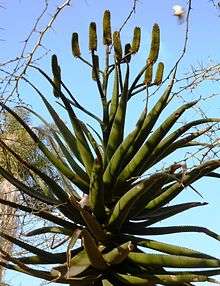Aloe rupestris
Aloe rupestris (known as the Bottlebrush Aloe) is an arborescent aloe indigenous to summer-rainfall areas of southern Africa.
| Aloe rupestris | |
|---|---|
 | |
| Aloe rupestris with its typical tall, multi-branched, "bottle-brush" inflorescence | |
| Scientific classification | |
| Kingdom: | Plantae |
| Clade: | Tracheophytes |
| Clade: | Angiosperms |
| Clade: | Monocots |
| Order: | Asparagales |
| Family: | Asphodelaceae |
| Subfamily: | Asphodeloideae |
| Genus: | Aloe |
| Species: | A. rupestris |
| Binomial name | |
| Aloe rupestris | |
| Synonyms | |
|
Aloe nitens Baker[2] | |
Description

The Bottlebrush Aloe gets its common name from its distinctive and showy flowers. The large candelabra inflorescences grow tall above the rosette. The numerous racemes on each inflorescence are straight, upright and cylindrical. The individual flowers begin as tight yellow buds that are packed densely on the racemes. When they open, bright reddish stamens extend far out, and give each raceme a fluffy "bottlebrush" look.
It is a very fast-growing aloe, which is usually single-stemmed in nature - though clumping, off-setting varieties seem to occur in cultivation. It grows extremely tall and its trunk is relatively thin, compared to other arborescent aloes. Therefore especially tall plants sometimes fall over when they do not have support (in their natural habitat, they tend to grow among rocks and thickets, which provide support).
The thin, partially recurved, spreading leaves form a dense rosette at the growth head of adult plants. They are smooth, dull green, deeply grooved (U shaped in cross-section) and have reddish-brown margins and slightly hooked teeth.
This species is frequently confused with the related Aloe thraskii, Aloe marlothii, Aloe ferox, Aloe speciosa, Aloe pluridens and Aloe excelsa species (among others) which have similar growth forms. However the inflorescence of the "Bottlebrush aloe" is distinctive, and its growth form is nonetheless recognisable. The flowers of Aloe excelsa have sloping or curved racemes, while Aloe thraskii has leaves that are more robust and strongly recurved.[3][4]
Distribution and habitat
Aloe rupestris occurs naturally across the south-eastern summer-rainfall areas of Kwazulu-Natal Province, South Africa, as well as Eswatini (Swaziland) and southern Mozambique.
Within this range, it favours rocky areas in bushveld, sandy coastal forest, and hilly areas where it occurs on rocky ridges and slopes (the species name "rupestris" means "of rocky places" in Latin).[5]
| Wikimedia Commons has media related to Aloe rupestris. |
References
- Martínez Richart, A.I. (2019). "Aloe rupestris". IUCN Red List of Threatened Species. 2019: e.T110784292A110784297. doi:10.2305/IUCN.UK.2019-1.RLTS.T110784292A110784297.en. Retrieved July 17, 2020.
- "Aloe rupestris Baker". Plants of the World Online. The Trustees of the Royal Botanic Gardens, Kew. n.d. Retrieved July 17, 2020.
- "Aloe rupestris, Kraalaalwyn, Information and Cultivation Tips". www.succulents.co.za. Retrieved 2017-08-01.
- "Introduction to Tree Aloes, part 1: the solitary, unbranched species - Dave's Garden". davesgarden.com. Retrieved 2017-08-01.
- http://www.cactus-art.biz/schede/ALOE/Aloe_rupestris/Aloe_rupestris/Aloe_rupestris.htm
[[Category:Taxa named by John Gilbert Baker
